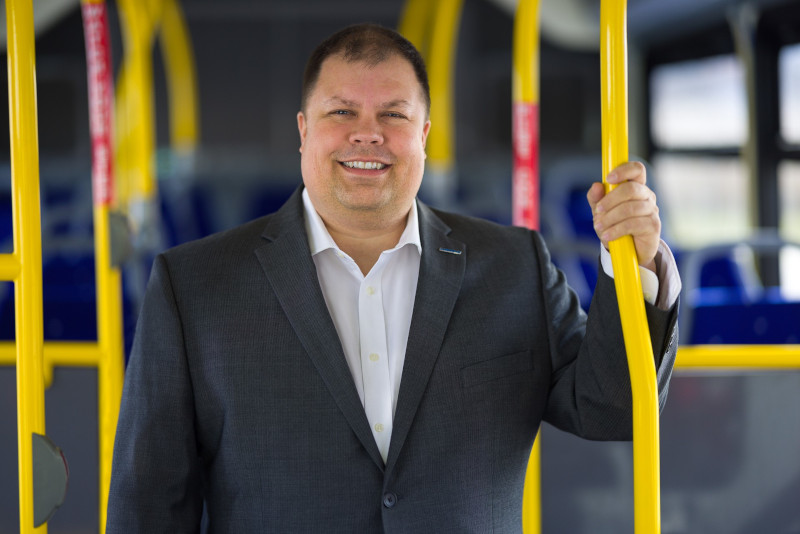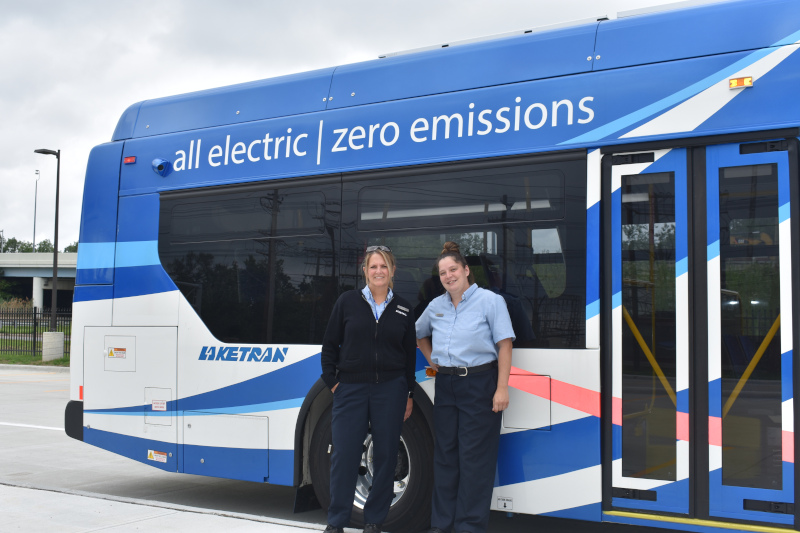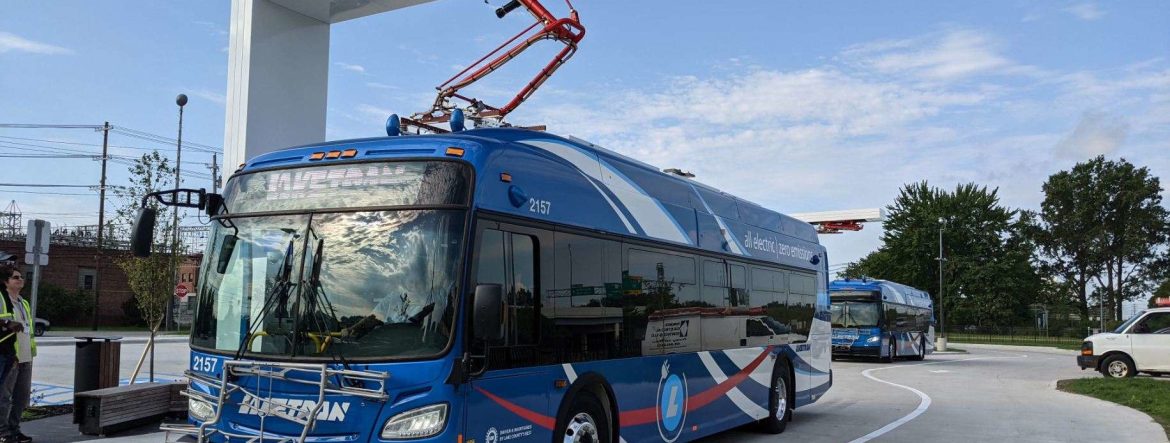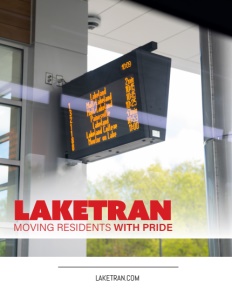Laketran
moving residents with pride
Serving the community, Laketran keeps moving forward with reliability
Proudly serving over 750,000 riders each year, Laketran is Lake County, Ohio’s regional public transportation system, and one of the most unique ones of its kind, not only in Ohio but in the U.S. As a suburban transit system, Laketran offers nine local fixed routes, its flagship Dial-a-Ride service, and three commuter Park-n-Ride routes with service between Lake County and downtown Cleveland.
The most popular service provided by Laketran is its Dial-a-Ride, which functions much like a taxi service but with door-to-door assistance. The shared-ride service generally transports between four to 10 customers at any time, continuing a tradition that has been in place for more than five decades. While a sizable percentage of riders using this service are seniors and individuals with disabilities, Laketran’s service is unique in offering this countywide paratransit service to the general public so any resident can benefit from it.
Best of all, residents can schedule their Dial-a-Ride by app, website, phone, or in person.

Ben Capelle, CEO
“In a way, it’s a rideshare or modern ‘microtransit’ concept, but we have been doing it for decades,” says Laketran CEO Ben Capelle.
Residents are charged a very affordable fare to improve the accessibility of the transit service. “The goal is to break down barriers and give everyone an opportunity for transportation when they need it.”
In 2021, Laketran carried 432,000 riders during the COVID-19 pandemic but traditionally serves over 750,000 customers each year. On average, the agency serves 300,000 passengers annually using in-county local routes, 160,000 Park-n-Ride customers commuting between Lake County and Cleveland, and 300,000 seniors and people with disabilities using Dial-a-Ride.
Capelle says while ridership fell in 2020, it has essentially recovered back to pre-pandemic levels and is projected to set a new ridership record in 2023.
Laketran’s fleet of buses consists of 17 kneeling New Flyer Xcelsior transit buses, of which 10 are battery-operated electric buses, 20 MCI motor coach buses for commuter service, and over 90 paratransit vans for Dial-a-Ride. To maintain a state of good repair, an average of 12 vehicles are replaced among the Dial-a-Ride fleet annually, as those buses generally turn over every six to seven years.
Laketran’s bus fleet is 100 percent ADA accessible and every bus is equipped with a wheelchair lift or ramp. Accessibility is very important at Laketran – not only in terms of equipment but to those who operate the system as well. Drivers receive training in CPR/First Aid, disability sensitivity, assisting passengers with service animals, communicating with hearing or visually impaired customers, maneuvering and securing mobility devices, and transferring individuals from mobility devices to a seat.
“Accessibility is important to us and is one of the reasons that our services are so popular with residents,” Capelle says.
Laketran tries to operate all of its buses sustainably through a cost-effective lens. The majority of the Dial-a-Ride fleet vehicles run on propane, which is both cleaner and less expensive to run. Propane costs around 70 cents a gallon compared to $3 a gallon for diesel fuel as of February 2023, according to Capelle.
The majority of Laketran’s fixed route fleet – about 60 percent– are electric. Through investment in on-route charging, the buses charge at strategic stops along their routes during the day rather than using traditional depot charging in a garage overnight. On-route charging saves on maintenance and operational costs, as well as the need to purchase additional transit buses. “It’s just more cost-effective than operating electric buses that can only be charged in the garage,” Capelle says.
He adds that Laketran began its journey with the electric business in 2016. Transitioning the fleet to electric buses was a progression that took up to five years from securing grant funding and the procurement process, to building the charging infrastructure and manufacturing the buses.
Today, Laketran uses all of its electric buses to their fullest potential, operating four of its nine fixed routes daily completely running on electricity.
With over 250 employees, Laketran is funded by a 0.5 percent sales tax within the county. That sales tax was increased by .25 percent by a majority vote of county residents in the 2019 election. “It was the latest example of how valuable the county considers this public transit system. Even though the COVID pandemic began a few months later, the increased funds have allowed Laketran to expand over the last three years, with new vehicles, more employees, and added services,” says Capelle.
Laketran’s 2021 operating expenses were $23 million with nearly 60 percent of the cost toward labor and benefits. Its recent increase in employees was a result of a targeted campaign to fill its driver and mechanic needs. This was originally difficult given the challenges in the labor market and the demand increase brought on by higher ridership.

Drivers Cindy Straub and Krystal DeMattia; among Ohios first drivers trained to driver Battery Operated electric buses.
“We were able to recruit and hire more than 75 new employees in the second half of 2022 alone,” says Capelle. Part of the reason Laketran was able to hire a larger group of drivers was an updated and improved pay structure to attract qualified candidates. Currently, 70 percent of the department’s employees are full and part-time bus drivers, 15 percent of employees are dispatchers and operation supervisors, and the remaining staff largely consists of maintenance and administrative employees.
“It’s been a struggle to find new employees but I think we’ve turned a corner. That’s important because demand for service is only going to increase alongside our community’s aging population,” says Capelle.
That increase in demand is proven by another large financial commitment – $22 million to renovate and expand Laketran’s headquarters to be able to operate 40 additional Dial-a-Ride vehicles. That investment makes the renovation the largest single construction project that the organization has ever undertaken. The expansion to its operations and maintenance facilities will be funded primarily by a competitive grant from the Federal Transit Administration that funds bus facility improvements.
Laketran has several goals it wants to accomplish in 2023 and beyond to provide an even higher level of service for residents. It is adding a new service to its Local Routes to serve Lake Erie College’s expanding campus, and already has a campus shuttle serving Lakeland Community College.
It is also a member of NEORide, a collaboration of 15 public transit systems across Ohio, Kentucky, and Michigan that have come together to offer a coordinated mobile ticketing app, EZfare. The regional partnership allows riders to pay bus fares for multiple systems using one app. The hope is to expand NEORide to include other transit systems across the Midwest and around the U.S. creating a uniform way for transit riders to pay their fare no matter what public transit system they are using.
“We want to make it a more reliable franchise,” Capelle says. “Right now, you go to most cities and each transit system has their own unique way to pay a fare and it’s confusing for riders. We want to change that and create a universal and convenient way to pay your fare no matter what transit system you need to use.”
One of the reasons Capelle and the executive team at Laketran desire such changes is to alter the stereotype of public transit in America. “Riding transit is a much more accepted practice in Europe and other parts of the world, but is often recognized as a second-class transportation option by many Americans. Transit needs to be modern, innovative, easy and accessible. That’s the reputation we’re creating in Lake County and what our residents have come to expect from us,” shared Capelle.
“If you ask anyone who lives in Lake County, I think they see the value and are proud of this service. It is a vital mode of transportation for many of our residents and Dial-a-Ride has a reputation as a lifeline for many.”
None of Laketran’s success and reputation strength would be possible without the support of numerous aforementioned partners and others like our Dial-a-Ride bus manufacturer, Oregon-Ohio based TESCO Bus Company and mobile fare payment software provider, Masabi.
By running lean, focusing on sustainability and service, and staying customer-focused, Laketran will continue to provide Lake County residents with some of the most comprehensive and innovative public transit services in the country for years to come. “We want to make public transit more an attractive option, while being efficient and accessible for all,” Capelle concludes.
AT A GLANCE
Laketran
What: dynamic public transport service serving residents with planned service expansions
Where: Lake County, Ohio
Website: https://laketran.com/



